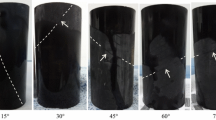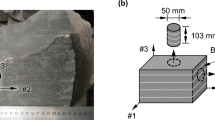Abstract
Properly accounting for the mechanical anisotropy of shales can be critical for successful drilling of high inclination wells, because shales are known to be weak along bedding planes. To optimize the drilling parameters in such cases, a sufficiently representative, anisotropic rock mechanical model is therefore required. This paper presents such a model developed to better match results from a dedicated, extensive set of uniaxial and triaxial compression tests performed on plugs of Mancos outcrop shale with different orientations relative to the bedding plane. Post failure inspection of the plugs shows that the failure planes are to some extent affected by the orientation of the applied stress relative to the bedding planes, indicating that the bedding planes may represent weak planes which tend to fail before intrinsic failure occurs, whenever the orientation of these planes is suitable. The simple “plane of weakness” model is commonly used to predict strength as function of orientation for such a rock. A comparison of this model to the experimental data shows, however, that the weak planes seem to have an impact on strength even outside the range of orientations where the model predicts such impact. An extension of this model allowing the weak planes to be heterogeneous in terms of patchy weakness was therefore developed. In this model, local shear sliding may occur prior to macroscopic failure, leading to enhanced local stresses and corresponding reduction in strength. The model is found to give better match with strength data at intermediate orientations. The model is also able to partly predict the qualitatively different variation of Young’s modulus with orientation for this data set.







Similar content being viewed by others
Abbreviations
- \(C_{0}\) :
-
Uniaxial compressive strength
- \(C_{ij}^{*}\) :
-
Effective stiffness matrix
- \(C_{ij}^{0}\) :
-
Initial stiffness matrix
- \(C_{ij}^{1}\) :
-
Crack impact matrix
- \(E\) :
-
Young’s modulus
- \(E_{0}\) :
-
Young’s modulus parallel to bedding
- \(G\) :
-
Shear modulus
- \(m\) :
-
Frictional resistance
- \(S_{0}\) :
-
Inherent cohesion
- \(S_{0w}\) :
-
Cohesion of weak planes
- \(T_{0}^{*}\) :
-
Minimum tensile strength
- \(\varepsilon_{z}\) :
-
Global axial strain
- \(\eta\) :
-
Patchiness parameter
- θ :
-
Inclination (angle between major principal stress and normal to weak planes)
- \(\nu\) :
-
Poisson’s ratio
- \(\xi\) :
-
Crack density
- \(\rho\) :
-
Excessive compliance associated with weak patches
- \(\sigma^{\prime}_{i}\) :
-
Effective principal stress number i
- \(\sigma^{\prime}_{z}\) :
-
Global effective axial stress
- \(\sigma^{\prime}_{{z,{\text{local}}}}\) :
-
Local effective axial stress
- \(\varphi\) :
-
Inherent friction angle
- \(\varphi_{w}\) :
-
Friction angle of weak planes
References
Duveau G, Shao JF, Henry JP (1998) Assessment of some failure criteria for strongly anisotropic geomaterials. Mech Cohes-Frict Mat 3:1–26
Fjær E (1999) Static and dynamic moduli of weak sandstones. In: Amadei B, Krantz, RL, Scott GA, Smeallie PH (eds) Rock mechanics for industry. Balkema, pp 675–681
Fjær E, Nes O-M (2013) Strength anisotropy of Mancos shale. In: Proceedings of the 47th US Rock mechanics/geomechanics symposium. ARMA, pp 13–519
Fjær E, Ruistuen H (2002) Impact of the intermediate principal stress on the strength of heterogeneous rock. J Geophys Res Solid Earth 107:ECV3-1–ECV3-10. doi:10.1029/2001JB000277
Fjær E, Holt RM, Horsrud P, Raaen AM, Risnes R (2008) Petroleum related rock mechanics. 2nd edn. Elsevier, Amsterdam
Griffith AA (1921) The phenomena of rupture and flow in solids. Phil Trans Roy Soc A 221:163–198
Hudson JA (1981) Wave speeds and attenuation of elastic waves in material containing cracks. Geophys J R Astr Soc 64:133–150
Jaeger JC (1960) Shear failure of anisotropic rock. Geol Mag 97:65–72
McLamore R, Gray KE (1967) The mechanical behavior of anisotropic sedimentary rocks. ASME J Eng Ind 89:62–73
Nes O-M, Brenna A, Gran K, Saasen A (2013) Borehole shale stability analysis to facilitate successful drilling of a horizontal well in the North Sea. In: Proceedings of the 47th US Rock mechanics/geomechanics symposium. ARMA, pp 13–346
Sarker R, Batzle M (2010) Anisotropic elastic moduli of the Mancos B Shale—an experimental study. Presented at the SEG Denver 2010 annual meeting
Tien YM, Kuo MC (2001) A failure criterion for transversely isotropic rocks. Int J Rock Mech Min Sci 38:399–412
Torsæter M, Vullum PE, Nes O-M, Rinna J (2012) Nanostructure vs macroscopic properties of Mancos shale. SPE 162737
Tsai SW, Wu EM (1971) A general theory of strength of anisotropic materials. J Comp Mat 5:58–80
Walsh J, Brace JF (1964) A fracture criterion for brittle anisotropic rock. J Geophys Res 69:3449–3456
Acknowledgments
This work was supported by the Strategic Institute Program “Gas shales for exploration and exploitation” at SINTEF Petroleum Research.
Author information
Authors and Affiliations
Corresponding author
Appendix
Appendix
The effective stiffness of a material containing a set of parallel cracks may be expressed as
\(C_{ij}^{0}\) is the initial stiffness and \(\xi\) is the crack density. If we assume that the cracks are closed and only can suffer shear sliding, the crack impact matrix \(C_{ij}^{1}\) is given as (see for instance Hudson 1981):
when the cracks are oriented normal to the z-axis. \(G\) and \(\nu\) are shear modulus and Poisson’s ratio, respectively, for the intact material. In Hudson’s model, \(m\) is a dimensionless parameter accounting for the impact of a viscous material filling the cracks. Here, we may consider \(m\) as a measure of the frictional resistance against shear sliding of the cracks.
We assume that the material obeys Hooke’s law, and consider a situation where it is loaded in one direction (\(\sigma^{\prime}_{z} > 0\)) at an angle \(\theta\) relative to the crack normal. To the lowest order in the crack density, the relation between stress and strain is then given as
Following Fjær (1999), we now assume that that the material consists of separate pillars, where some are penetrated by a crack while others are intact. The stress \(\sigma^{\prime}_{{z,{\text{local}}}}\) in the intact pillars is given by the inherent stiffness \(E_{0} = 2G\left( {1 + \nu } \right)\) and global strain \(\varepsilon_{z}\) which relates to the global stress \(\sigma^{\prime}_{z}\) according to Eq. 12:
The intact pillars will fail when the local stress reaches the inherent strength; hence the global strength of the material is defined by \(\sigma^{\prime}_{{z,{\text{local}}}} = C_{0}\) which combined with Eq. 13 gives the expression for global stress at failure:
Rights and permissions
About this article
Cite this article
Fjær, E., Nes, OM. The Impact of Heterogeneity on the Anisotropic Strength of an Outcrop Shale. Rock Mech Rock Eng 47, 1603–1611 (2014). https://doi.org/10.1007/s00603-014-0598-5
Received:
Accepted:
Published:
Issue Date:
DOI: https://doi.org/10.1007/s00603-014-0598-5




